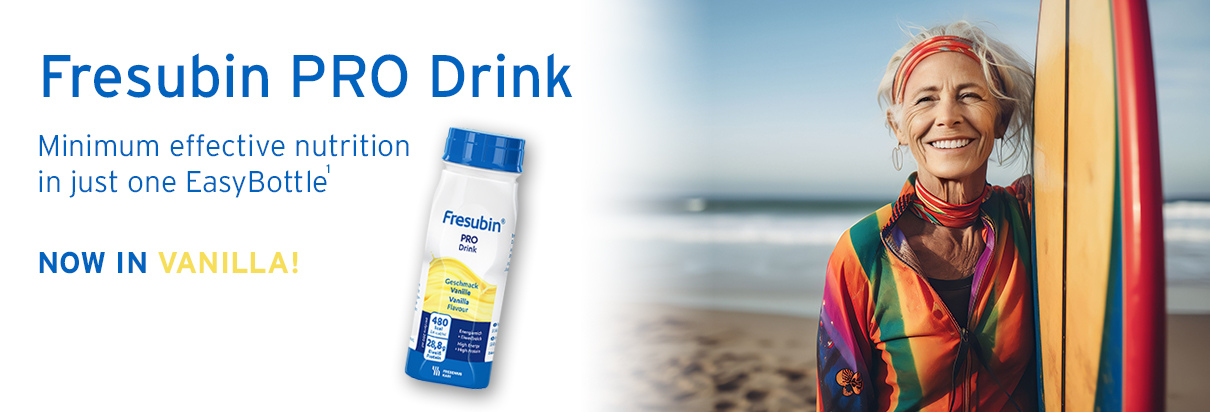
Malnutrition is a growing problem which is often overlooked, risking up to 50% of older Australian hospital patients2.
Sarcopenia, frailty or age-related musculoskeletal deficits e.g. osteoporosis, that are typically linked with malnutrition in older adults may have a negative impact on quality of life3.
By consuming an energy-dense oral nutritional supplement like Fresubin PRO, it may help to improve nutrient intake to support muscle and bone health1.
Sarcopenia
Progressive and generalised loss of skeletal muscle mass and strength.
Frailty
Age-related loss of skeletal muscle mass with physical function impairment.
Osteoporosis
Characterised by progressive bone mineralisation loss over time leading to reduced bone mass and fragmentation of bone architecture.



*Due to malnutrition and other causes

Fresubin® PRO Drink
Fresubin PRO is available in three delicious flavours: Hazelnut, Neutral and now introducing Vanilla!
With a proven good taste, Fresubin PRO Drink can support compliance with high quality nutrition in just one bottle!1,9
Fresubin® PRO Drink Vanilla received a positive rating in an independent taste study.*
*SAM Sensory Consumer Research 2021

High Energy content of
480 kcal / 200 ml
To provide the minimum effective dose and improve compliance to recommended intake of energy in one bottle1.

High Protein content of
28.8 g / 200 ml
The effective dose to maximally stimulate and sustain muscle protein synthesis in malnourished patients with increased needs10.

10 μg Vitamin D &
700 mg Calcium
50% of daily vitamin D needs11,12 and 78% of daily calcium needs13 that help to support musculoskeletal integrity in combination with high protein14
Approved Good Taste
Energy dense formula and tasty flavour options help to improve compliance9.
Fresubin® PRO Drink is part of our initiative to make our EasyBottles more sustainable

Fresubin® 200 ml EasyBottle
30% reduction
in plastic
since 2011
References
1. Volkert D. Current ESPEN Guideline Clinical Nutrition and Hydration in Geriatrics. Dtsch Med Wochenschr. 2020 Sep;145(18):1306-1314.
2. Dietitians Australia (2020) Position Statement: Malnutrition in Aged Care. Accessed May 2024, at https://dietitiansaustralia.org.au/sites/default/files/2021-12/202012-PositionStatement-Malnutrition_in_Aged_Care.pdf
3. Rizzoli R et al.Quality of Life in Sarcopenia and Frailty. Calcif Tissue Int. 2013; 93(2): 101-120
4. Taafe, D.R. (2014) Sarcopenia: Exercise as a treatment regime. The Royal Australian College of General Practitioners, Clinical Update. Accessed May, 2024 at https://www.racgp.org.au/getattachment/431ab203-e171-4de7-b511-cc4f7a254b38/attachment.aspx
5. Morley JE, Anker SD, von Haehling S (2014) Prevalence, incidence, and clinical impact of sarcopenia: facts, numbers, and epidemiology—update, J Cachexia Sarcopenia Muscle (2014) 5:253–259
6. Artaza-Artabe I, Saez-Lopez P et al. The relationship between nutrition and frailty: Effects of protein intake, nutritional supplementation, vitamin D and exercise on muscle metabolism in the elderly. Mauritas 2016; 93: 89-99
7. Verlaan S, Ligthart-Melis GC et al. High Prevalence of Physical Frailty Among Community-Dwelling Malnourished Older Adults – A Systematic Review and Meta-Analysis. J Am Med Dir Assoc 2017; 18(5): 374-382
8. Hernlund E, Svedbom A et al. Osteoporosis in the European Union: medical management, epidemiology and economic burden. Arch Osteoporos 2013; 8: 136 - 151
9. Ozcagli TG et al. (2013) A study in four European countries to examine the importance of sensory attributes of oral nutritional supplements on preference and likelihood of compliance. Turk J Gastroenterol 24: 266-272.
10. Paddon-Jones D, Rasmussen BB. Dietary protein recommendations and the prevention of sarcopenia. Curr Opin Clin Nutr Metab Care. 2009;12(1):86-90.
11. EFSA NDA Panel. Scientific Opinion on Dietary Reference Values for vitamin D. EFSA Journal 2016;14(10): 4547, doi: 10.2903/j.efsa.2016.4547.
12. National Health and Medical Research Council: Nutrient Reference Values Australia and New Zealand. https://www.eatforhealth.gov.au/nutrient-reference-values. Accessed May, 2024.
13. EFSA NDA Panel Scientific Opinion on Dietary Reference Values for calcium. EFSA Journal 2015;13(5):4101, 82 pp. doi:10.2903/j.efsa.2015.4101
14. Morley JE, Vellas B, van Kan GA, Anker SD, Bauer JM, Bernabei R, et al. Frailty consensus: a call to action.J Am Med Dir Assoc. 2013;14(6):392-7.

